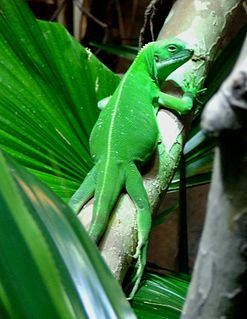
The Lacertidae are the family of the wall lizards, true lizards, or sometimes simply lacertas, which are native to Europe, Africa, and Asia. The group includes the genus Lacerta, which contains some of the most commonly seen lizard species in Europe. It is a diverse family with at least 300 species in 39 genera.

Nucras is a genus of African lacertid lizards, commonly called sandveld lizards.

Ophisops is a genus of wall lizards of the family Lacertidae. They are small lacertids characterized by transparent lower eyelids that are completely or partially fused with the upper lids to form a cap over the eye. Species of the genus Ophisops are distributed in southeast Europe, northeast Africa, to west Asia.

Barkudia insularis commonly known as the Madras spotted skink is a critically endangered limbless skink which was described in 1917 by Nelson Annandale and rediscovered in the wild in 2003. Little is known about the species but it is believed to be found only in the mangrove habitats near Barkud Island in Chilka Lake, Odisha, India. The lizard looks like a large earthworm and lives in the subsoil and probably feeds on small arthropods.

The slender glass lizard is a legless lizard in the family Anguidae. The species is endemic to the United States. Two subspecies are recognized. The lizard was originally believed to be a subspecies of the eastern glass lizard. Their name comes from their easily broken tail which they can break off themselves without ever being touched. It is difficult to find a specimen with an undamaged tail. The lizard eats a variety of insects and small animals, including smaller lizards. Snakes and other animals are known to prey on the species. Humans have a part in destroying their environment and killing their food supply with insecticides. The lizard is considered to be a least-concern species according to the International Union for Conservation of Nature (IUCN), though it is vulnerable in Iowa and endangered in Wisconsin.

Ophisops beddomei, commonly known as Beddome's snake-eye or Beddome’ s lacerta, is a species of lizard in the family Lacertidae. The is a diurnal and fast-moving terrestrial lizard, that is endemic to the Western Ghats of India.

Ophisops elegans, commonly known as the snake-eyed lizard, is a species of lizard in the family Lacertidae. The species is endemic to the Mediterranean region and Central Asia. There are nine recognized subspecies.

Ophisops jerdonii, commonly known as Jerdon's cabrita, Jerdon's snake-eye, or Punjab snake-eyed lacerta, is a species of lacertid lizard, which is distributed in east Afghanistan, Pakistan, and India.
Ophisops microlepis, the small-scaled lacerta, is a species of lizards found in parts of India.

The Soutpansberg flat lizard is a species of lizard in the Cordylidae family.
Ophisops occidentalis, the western snake-eyed lizard is a species of lizard in the family Lacertidae. It is found in Algeria, Egypt, Libya, Morocco, and Tunisia. Its natural habitats are temperate forest, Mediterranean-type shrubby vegetation, subtropical or tropical dry lowland grassland, and rocky areas. It is threatened by habitat loss.

Brachylophus bulabula is a species of iguanid lizard endemic to some of the larger central and northwestern islands of Fiji, where it occurs in Fijian wet forest. It was described by a team led by a scientist from the Australian National University in 2008. It is one of the few species of iguana found outside of the New World and one of the most geographically isolated members of the family Iguanidae. Initially also reported from Gau Island, in 2017 this population was described as a separate species, B. gau.
Mesalina ayunensis, also known as the Ayun sand lizard or Arnold's sand lizard, is a species of sand-dwelling lizard in the family Lacertidae. It is endemic to Oman.
Ophisops kutchensis, the Kutch small-scaled snake-eye, is a wall lizard in the family of true lizards (Lacertidae). It is endemic to India.
Ophisops pushkarensis, the Pushkar small-scaled snake-eye, is a wall lizard in the family of true lizards (Lacertidae). It is endemic to India.
Omanosaura cyanura, the blue-tailed lizard or blue-tailed Oman lizard, is a species of lizard in the family Lacertidae. It is found in Oman and the United Arab Emirates.

Omanosaura jayakari, the Jayakar lizard or Jayakar's Oman lizard, is a species of lizard in the family Lacertidae. It is found in Oman and the United Arab Emirates.











